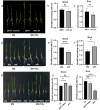TiO2 nanomaterial promotes plant growth and disease resistance
- PMID: 40444705
- PMCID: PMC12128655
- DOI: 10.1080/15592324.2025.2512943
TiO2 nanomaterial promotes plant growth and disease resistance
Abstract
TiO2 nanomaterials can promote plant growth and enhance disease resistance. However, the underlying mechanism remains unclear. This study applied TiO2 to promote the growth of wheat, soybean, tobacco, cucumber, and corn. Genetic analysis using macro-element transporter rice mutants in rice revealed that growth promotion induced by TiO2 was dependent on potassium transporter (AKT1), nitrate transporter 1.1B (NRT1.1B), ammonium transporter 1 (AMT1), and phosphate transporter 8 (PT8). TiO2 also enhanced chlorophyll accumulation, and growth promotion was inhibited in the chlorophyll biosynthesis rice mutants, yellow-green leaf 8 (ygl8) and divinyl reductase (dvr), indicating that TiO2 promoted growth through chlorophyll biosynthesis. In addition to photosynthesis, TiO2 affected light signaling by inhibiting the translocation of Phytochrome B (PhyB) from the cytosol to the nucleus, thereby improving resistance to rice sheath blight (ShB). TiO2 application also enhanced resistance to wheat stem rust, tobacco wildfire, angular spot disease, and rice ShB by inhibiting the growth of bacterial and fungal pathogens, suggesting that TiO2 regulates plant defense signaling and has antibacterial and antifungal effects. Field experiments with wheat, soybeans, and rice confirmed that TiO2 treatment significantly increased the crop yield. These findings suggest that TiO2 is a promising nanomaterial for the simultaneous enhancement of plant growth and disease resistance.
Keywords: TiO2; disease resistance; nutrient uptake; plant growth promoting; yield increase.
Conflict of interest statement
No potential conflict of interest was reported by the author(s).
Figures








Similar articles
-
Carbon nanosol promotes plant growth and broad-spectrum resistance.Environ Res. 2024 Jun 15;251(Pt 1):118635. doi: 10.1016/j.envres.2024.118635. Epub 2024 Mar 8. Environ Res. 2024. PMID: 38462083
-
Phytochrome B-mediated light signalling enhances rice resistance to saline-alkaline and sheath blight by regulating multiple downstream transcription factors.Plant Biotechnol J. 2025 May;23(5):1476-1490. doi: 10.1111/pbi.14599. Epub 2025 Jan 31. Plant Biotechnol J. 2025. PMID: 39890591 Free PMC article.
-
Mutation of phytochrome B promotes resistance to sheath blight and saline-alkaline stress via increasing ammonium uptake in rice.Plant J. 2023 Jan;113(2):277-290. doi: 10.1111/tpj.16046. Epub 2022 Dec 8. Plant J. 2023. PMID: 36440495
-
Progress in rice sheath blight resistance research.Front Plant Sci. 2023 Mar 24;14:1141697. doi: 10.3389/fpls.2023.1141697. eCollection 2023. Front Plant Sci. 2023. PMID: 37035075 Free PMC article. Review.
-
Role of silicon in elevating resistance against sheath blight and blast diseases in rice (Oryza sativa L.).Plant Physiol Biochem. 2021 Sep;166:128-139. doi: 10.1016/j.plaphy.2021.05.045. Epub 2021 May 28. Plant Physiol Biochem. 2021. PMID: 34102436 Review.
References
-
- Barhoum A, García-Betancourt ML, Jeevanandam J, Hussien EA, Mekkawy SA, Mostafa M, Omran MM, Abdalla M, Bechelany M.. Review on natural, incidental, bioinspired, and engineered nanomaterials: history, definitions, classifications, synthesis, properties, market, toxicities, risks, and regulations. Nanomaterials. 2022;12(2):177. doi:10.3390/nano12020177. - DOI - PMC - PubMed
-
- Wahab A, Muhammad M, Ullah S, Abdi G, Shah GM, Zaman W, Ayaz A. Agriculture and environmental management through nanotechnology: eco-friendly nanomaterial synthesis for soil-plant systems, food safety, and sustainability. Sci Total Environ. 2024;926:171862. doi:10.1016/j.scitotenv.2024.171862. - DOI - PubMed
-
- Chhipa H. Nanofertilizers and nanopesticides for agriculture. Environ Chem Lett. 2017;15(1):15–12. doi:10.1007/s10311-016-0600-4. - DOI
MeSH terms
Substances
LinkOut - more resources
Full Text Sources
Miscellaneous
